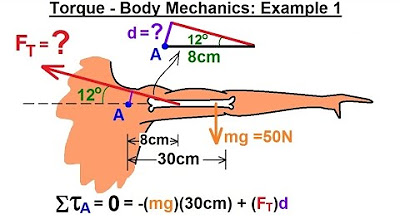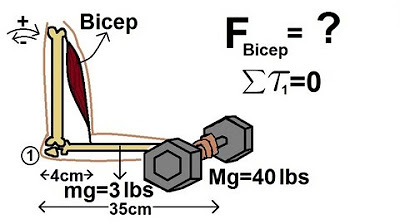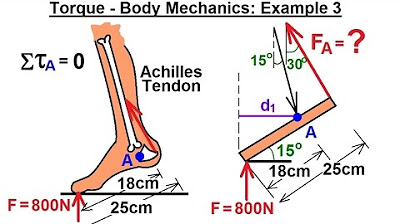Physics 15 Torque (17 of 25) Body Mechanics: Ex. 5, F=? Leg Lifting Weights
TLDRThe video script explores the mechanics of how the human body, specifically the lower leg and thigh muscle, can lift a significant weight. It uses the example of a 100-pound weight being lifted by the lower leg, with the muscle force exerted through a tendon at an angle. The script explains the concept of torque and equilibrium, leading to a calculation of the force required by the thigh muscle to hold the weight stationary. It concludes with the surprising result that the muscle must exert a force of 799 pounds to lift or hold the weight, emphasizing the incredible strength of human muscles. This educational content provides insight into the physics of human movement and the powerful forces at work in our bodies.
Takeaways
- 📐 The lower leg is lifted by the action of the calf muscles, which are connected to the leg bone via a tendon.
- 🔵 The tendon exerts a force on the leg bone to hold up the weight of the lower leg and any additional weight attached to the foot.
- 📏 The angle of the lower leg (4 degrees) and the angle of the tendon relative to the bone (25 degrees) are crucial in calculating the force exerted.
- ⚖️ The problem is approached by considering the equilibrium of torques around the knee joint, which must sum up to zero.
- 🧮 The weight of the lower leg is assumed to be at its midpoint, and the perpendicular distance from the force line of action is calculated.
- 📐 The perpendicular distance from the tendon's line of action to the pivot point is found using trigonometric relationships.
- 🔢 The force exerted by the tendon is calculated by balancing the torques, taking into account the angles and distances involved.
- 🤸♂️ The actual weight of the lower leg is corrected to a more reasonable 10 pounds, instead of an unrealistic 100 pounds.
- 📉 The weight of the additional load (100 pounds) and the force exerted by the tendon are used to calculate the required force (799 pounds).
- 💪 The human body's muscles are incredibly strong, capable of exerting substantial forces to perform various motions and maintain postures.
- 🏋️♀️ Regular gym users can develop the strength to exert such forces, demonstrating the power of human musculature.
Q & A
What is the primary focus of the lecture?
-The lecture focuses on demonstrating how the mechanics of the human body, specifically the lower leg and the tendons, work to lift and support weight.
What is the angle formed by the lower leg in this example?
-The angle formed by the lower leg in this example is four degrees.
What is the role of the tendon in this scenario?
-The tendon is connected to the leg bone and is responsible for pulling on the bone to suspend the weight of the lower leg and any additional weight connected to the foot.
What is the approximate distance of the attachment point of the tendon from the total length of the leg bone?
-The tendon is attached at a distance of 1/5 the total length of the leg bone.
What is the approximate angle between the direction of the tendon and the direction of the bone?
-The angle is approximately 25 degrees.
What is the assumption made about the center of mass of the lower leg?
-The center of mass of the lower leg is assumed to be at about the halfway point of the leg.
What is the force exerted by the tendon in terms of the perpendicular distance from the line of action to the pivot point?
-The force exerted by the tendon is calculated using the perpendicular distance from its line of action to the pivot point, taking into account the angle of the tendon and the cosine of that angle.
What is the significance of the angle theta in the calculation?
-Theta is the angle between the perpendicular to the bone and the direction of the force exerted by the tendon. It is crucial for calculating the torque produced by the tendon.
What is the calculated force required by the thigh muscle to hold up a 100-pound weight at a 40-degree angle?
-The calculated force required by the thigh muscle is 799 pounds.
Why is it important to consider the torque in the equilibrium of the system?
-Considering the torque is important because it ensures that the sum of all the torques about a point is equal to zero, which is a condition for mechanical equilibrium.
How does the lecture illustrate the strength of human muscles?
-The lecture illustrates the strength of human muscles by calculating the force required to hold a certain weight at a specific angle, demonstrating the enormous strength needed for such a task.
What is the practical application of understanding the mechanics of muscle force in daily life or exercise?
-Understanding the mechanics of muscle force helps in designing effective exercises and physical training programs that target specific muscle groups and improve overall physical performance.
Outlines
🔍 Mechanics of Lifting Weight with the Lower Leg
This paragraph explains the biomechanics of lifting a heavy weight using the lower leg. It discusses how the angle of the lower leg, the force exerted by the muscle through the tendon, and the weight of the lower leg itself contribute to the ability to lift a weight. The paragraph explores the concept of torque and equilibrium around the knee joint, using the weight of the lower leg and an additional hundred pounds as examples. It also calculates the force required on the tendon to maintain equilibrium, taking into account the angle of the tendon's pull and its distance from the pivot point.
📐 Correcting the Weight and Calculating Muscle Force
The second paragraph corrects the weight of the lower leg from an unrealistic hundred pounds to a more reasonable ten pounds, and continues the biomechanical analysis. It outlines the process of calculating the force exerted by the thigh muscle (F) that is transmitted through the tendon to lift or hold a weight. The calculation involves finding the torque created by the weight and the muscle force, and solving for F using trigonometric relationships. The final calculation reveals that a force of 799 pounds is required by the thigh muscle to hold the weight stationary, illustrating the significant strength of human muscles.
Mindmap
Keywords
💡Mechanics
💡Torque
💡Equilibrium
💡Tendon
💡Angle of Force
💡Cosine of Angle
💡Sine of Angle
💡Center of Mass
💡Perpendicular Distance
💡Thigh Muscle
💡Strength of Muscles
Highlights
The lecture discusses how the human body uses mechanics to lift heavy weights, providing insight into the force exerted by muscles.
A 100-pound weight is used as an example to illustrate the mechanics of lifting with the lower leg.
The current angle of the lower leg is noted to be four degrees, which is significant for the force calculation.
The time muscle is identified as the key muscle involved in lifting the leg, connected via a tendon to the leg bone.
The tendon's force is calculated based on its distance from the leg bone, which is one-fifth of the total leg bone length.
The angle between the tendon and the bone is approximately 25 degrees, affecting the torque calculation.
The concept of equilibrium is introduced, stating that the sum of torques about the knee equals zero.
The weight of the lower leg is considered, with the center of mass assumed to be at the halfway point.
The perpendicular distance from the line of action of the force to the pivot point is identified as a key factor in the calculation.
The angle theta is defined as the angle between the perpendicular to the bone and the direction of the force.
The torque caused by the tendon is calculated using the length of the leg bone and the cosine of the angle theta.
The force exerted by the tendon is found by solving a system of equations representing the torques.
The weight of the lower leg is corrected to 10 pounds for a more realistic calculation.
The force required by the thigh muscle to hold the weight is calculated to be 799 pounds.
The strength of the human muscles is highlighted, emphasizing the body's ability to perform various motions.
The lecture concludes by emphasizing the importance of understanding muscle strength and force in human motion.
Transcripts
Browse More Related Video

Physics 15 Torque (14 of 27) Body Mechanics: Ex. 2, F=? To Lift Dumbbell

Physics 15 Torque (13 of 27) Body Mechanics: Ex. 1, F=? To Lift Up Arm

Physics 15 Torque (18 of 25) Body Mechanics: Ex. 6, F=? on Back Muscle

Physics 15 Torque (16 of 25) Body Mechanics: Ex. 4, F=? Jaw Muscle

Physics 15 Torque Example 5 (5 of 7) The Bicep

Physics 15 Torque (15 of 27) Body Mechanics: Ex. 3, F=? on Achilles Tendon***
5.0 / 5 (0 votes)
Thanks for rating: